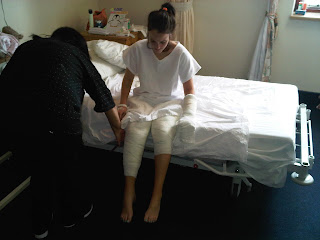Amy in Hospital
Somehow we find the strength to do what we have to do when we are put in charge. I rationalise that the only reason I could stand there frozen in shock and screaming during the actual accident was that Guy was there and I had full confidence that he would act - as he did.
Thereafter, I had managed to run around doing whatever was needed (including getting another lad under the shower once Amy was in the bath, since he had had a relatively minor flash burn from the explosion), and then to be calm for Amy while she was in the bath, stopping her from hyperventilating and holding her - and she was so very brave despite the terrible pain she was in. I had managed to be calm for Amy in the ambulance when she screamed deep blood curdling screams all the way to the hospital because the movement of the ambulance caused her agonising pain and there was nothing to ease the pain bar one inadequately sized burn shield.
But as soon as I handed her over to the nurses' care and they began infusing her with morphine, I began to faint and had to go and lie down myself. ER filled up with family and friends - and I was the only one fainting and shaking and nauseous! Even Amy was joking now that she had enough morphine in her to sink a battleship.
Part of my reaction was the after effect of shock and part was from knowing that this was only the beginning for Amy. The extent of her burns was that both of her thighs were burned all round and on her right leg the burns extended to half way down her calf. Her left hand was burned and there were two small burns on her upper arm and chest.
Her initial surgery for debridement and dressing took three hours instead of the original estimation of one hour given to us - causing me further nausea from fear. And I continued to shake and feel nauseous for the next two days, until I woke one morning and realised that the flames were over and were actually in the past. After that, I actually coped better emotionally than Guy.
Guy's was the hero part - and mine was the part of mothers since time immemorial - nursing one's child. The hospital was very good about letting me sit all day with Amy - keeping away as many visitors as possible, trying to get food and drink into her, and doing all the many tiny errands that she could not do for oneself, since for several days she had to remain mostly in the same position. Being helpless was especially tough for my highly independent daughter! In particular, she needed to have her feet carefully massaged every few hours - which I enjoyed doing for her. The right foot (the more badly burned leg) was swollen because the lymph drainage in that leg had been compromised and so that foot in particular had to be gently massaged often to encourage deeper tissue drainage.
Amy was remarkably positive overall and was both popular with the nurses and impressed the senior medical staff with her keen interest to know what was going on so that she could prepare and adapt(though the moment the pain meds started waning she was in terrible pain again) and set herself goals no matter how small to move herself towards healing. Amy is a little person and there was a lot going on in her body for her to cope with. And from my part it was not all just sitting patiently waiting for Amy to leave hospital. Every day brought another challenge and we could only live through it all from moment to moment – and I did worry profoundly, though I kept it away from Amy for the most part.
I had not realised beforehand how complex a burn injury is, particularly a flame burn.
Firstly - the burns are of uneven depths and this alone makes dealing with them complex.
Secondly - the tissue damage continues to develop beneath the surface of the burnt area for the next five days or so (which is also why first aid by lengthy water immersion to draw away the heat is so important to limiting the damage). So no skin grafting can be done before the wound stabilises. Every 2 days or so, the surgeon assessed the damage as he cleaned and redressed the burns while Amy was under general anaesthetic. And of course having general anaesthetic every couple of days brings its own set of problems, not least that Amy’s veins in her arms were taking great strain!
Thirdly, because the skin barrier has been destroyed, burn wounds leak like a sieve. The body loses not only fluid, salts, vitamins and so on, but also blood proteins, like albumin which buffers the blood pH and antibodies that fight infection.
All this leakage has effects on blood pressure and kidney function. For several days in hospital, Amy’s blood pressure was about 60/40 and her heart rate was well over 100. There is also a risk that blood vessels in the burned area can become blocked or collapse, promoting infection, stroke or heart attack.
Part of the answer is to drink as much as possible and eat lots – especially protein. The dietician prescribed protein supplements – which have to be balanced and low fat. Then extra vitamins are needed, especially D (to boost immune function) and C and Zinc.
Part of the problem was that Amy, who has had a tiny appetite since birth and now was nauseous and probably a bit out of it from morphine – refused to eat or drink! Part of the solution was mother constantly making sure that something was going in – and at one point actually having an angry argument about it – mere days from being so grateful that Amy had survived! And part of the solution was Amy's uncle, who is a chef, making her a series of delicious appetite tempting soups!
Tissue leakage also raises the risk of infection – both from normal skin surface bugs (mostly Streptococcus, Staphylococcus and Pseudomonas) proliferating on the nice leaking serum (which smelled much like the foetal calf serum which we used in the lab as a tissue culture medium additive!) – and from the risk of pneumonia. Hence the isolation ward. Fortunately, Amy had only two mild surface infections – treated with silver dressing.
She was also lucky that her surgeon did a research PhD and as a result was more ready to try new treatments (while remaining properly cautious of course) – and so she was one of the first people in Cape Town to extensively use Suprathel, a German polymeric artificial skin covering that encourages better healing of burn wounds and reduces infection. Thanks to this, Amy’s hand needed no grafting as had first been estimated and healed beautifully, and the extent of grafting needed on her legs was dramatically reduced.
Amy taking her first few assisted steps from the bed to the chair after one week in hospital
Amy and friends one day after admission - Amy on heavy morphine!
Note her bandaged hand had been decorated as a dog's face by her boyfriend's father.
This bandage was removed after a few days and replaced with a heavier cast to keep her fingers straight.
There was an additional “problem”. Amy is very pretty and was being very positive (and was on heavy doses of pain killers), so apart from her bandaged arm, no visitor could really see the damage to her heavily bandaged legs and thought that she was stronger than she actually was. Amy enjoyed visitors but the visits really tired her - and I was paranoid about infection. So I had to play gate-keeper and in the end we put up a notice on her door for a week or so saying please no visitors.
No two burn wounds are ever alike and the surgeon has to assess the wounds every time he does a dressing change. There is a window for optimal grafting success and the surgeon has to balance between waiting to see how much healing will happen spontaneously and not waiting too long to graft.
Finally, the surgeon announced that he would have to do some grafting. We all knew that this would be the case, yet when actually faced with the prospect – and seeing his photos of her legs, which was the first time that I had seen what they looked like since she went into hospital – I became nauseous and felt like collapsing again. On hearing that she needed grafts, Amy cried for the first time since being in hospital. Having said that, we were all grateful that she was in a position to be able to have grafts!
Amy was also extremely lucky that although she has had grafts above and below the back of her right knee joint, the skin in the fold of the knee was still intact, and so she has no joint mobility problems from having a single graft over the back of the knee.
Fortunately as well, the upper thigh of one leg still had some original skin on it and this became the graft donor site. Of course this necessarily created two new wounds.
Because of the positions of the grafts and because the first five days are critical to the grafts taking, Amy had to be completely immobilised in bed with her leg in a splint for five days.
Finally, Amy was allowed to go home – but that was by no means the end of it!









